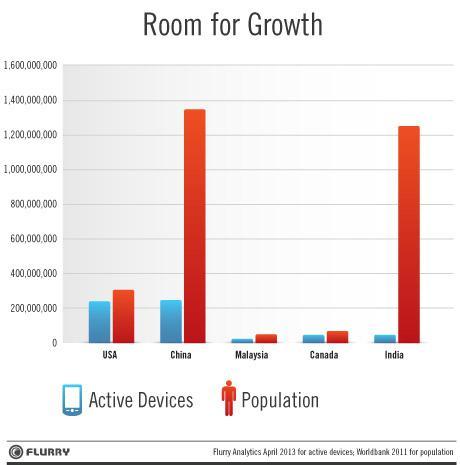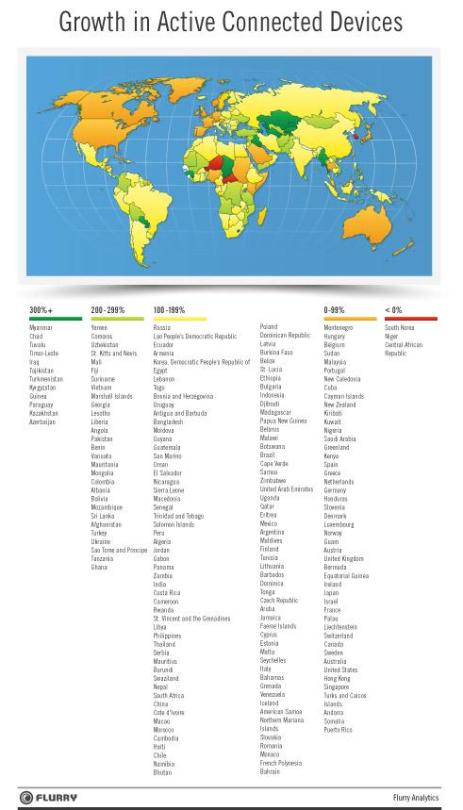Flurry measured a 47% increase in active smartphones and tablets in the United States between April of 2012 and April of 2013. While that number sounds impressive, it actually puts the U.S. in the bottom 5% of countries for connected device growth in the past year. Worldwide, growth of these devices is exploding. To be in the top 5% of countries for growth over the past year, a country’s number of active connected devices needed to more than triple.
There are currently more than one billion active smartphones and tablets globally, and based on current growth rates we expect to reach two billion in 2014. In this report we discuss which countries are growing fastest, and the implications for the mobile ecosystem and for society more generally.
The reason even 47% growth puts the US near the bottom of countries for tablet and smartphone growth becomes clear from comparing the size of the connected device installed base and population in five countries.
Let’s start by considering China and the U.S. These two countries currently have a similarly sized connected device installed base, but China has more than four times as many people.Combine China’s largely untapped population with its rapidly growing incomes (increasing at a rate of 8-10% a year between 2009 and 2011, according to the World Bank), and it’s not surprising that the connected device installed base in China grew by 149% between April of 2012 and April of 2013.

We expect these same forces to continue fueling growth in connected device numbers in China, and given the size of the Chinese population, those numbers could add up quickly. For example, if penetration of smartphones and tablets in China grew to that of Malaysia then 210,507,168 additional connected devices would be added to China’s installed base. We chose Malaysia as a point of comparison because it has a large Chinese population and per capita incomes where China’s are likely to be in the not too distant future.
Canada and India provide an even more dramatic comparison. They currently have similarly sized installed bases of smartphones and tablets, but India’s population is 36 times as big as Canada’s. Of course, India’s device penetration won’t catch up to Canada’s overnight, but when India’s rate of penetration equals the current rate in China, then 197,561,626 additional devices will be added to the worldwide installed base. Given India’s connected device installed base grew by 160% in the past year, we don’t think that’s going to take that long to happen.
For those keeping count, that means that the world’s number of connected devices will increase by more than 400 million (or about 40%) when the rate of penetration in India reaches the current rate of penetration in China, and the rate of penetration in China reaches the current rate of penetration in Malaysia.
India and China’s large populations make them dramatic examples, but their rates of growth don’t even put them at the top of the charts.Use of smartphones and tablets grew in every country in the world last year except for the three (The Central African Republic, Niger, and South Korea) shown in red in the map below. South Korea was one of the earliest adopters of mobile technology, and it appears that its market is now saturated. The countries in orange (mainly the English speaking countries, Western European countries, and the most connected parts of Asia) are other early adopters of mobile technology. Those markets still grew at rates of up to 99%, but a lot of that growth was the result of people adopting tablets as second devices.

The countries in yellow and green all saw their mobile installed bases more than double in the one year period between April of 2012 and April of 2013.That phenomenal rate of growth is all the more impressive considering what a large proportion of the world’s land mass and population those countries represent. The mobile markets of all of the large BRIC countries (Brazil, Russia, India, China) grew by between 100 and 199% (the growth rate for the yellow countries on the map). Much of the rest of South America and parts of Africa also grew at that same rate.
The number of active connected devices in countries in green in the map grew at 200% or more in the year to April 2013; those shown in the darker green had growth of 300% or more. Many of these hyper-growth countries are relatively small and not particularly affluent, so their fast growth in the past year may be a reflection of their wireless infrastructure catching up enough to allow their citizens to participate in the mobile revolution.
The discussion up to now clearly points to rapid growth in the connected device installed base coming predominantly from countries that have a lot of headroom for growth because their current rate of penetration is relatively low. That has the potential to change the foundation of the mobile ecosystem. We have become used to a world in which connected devices are reasonably expensive and replaced fairly frequently, and in which apps for those devices are developed by people in relatively affluent countries. As we look toward the connected device installed base doubling to more than two billion, we expect more of a focus on lower-cost devices that are also possibly more robust (to allow for less frequent replacement since that may be unaffordable in lower income countries). We also expect to see greater diversity of apps and app developers as apps are developed to meet the needs of increasingly diverse device users.
Things get even more interesting when we consider what people might be doing with all of those devices. Of course, they will still provide communication and entertainment, but we expect mobile devices to play an increasingly large role in many aspects of life including enabling commerce in growing economies, facilitating medical care in remote areas, and ensuring that people throughout the world have access to world-class educational resources. We can’t wait to see what else the next billion smartphones and tablets will be used for!